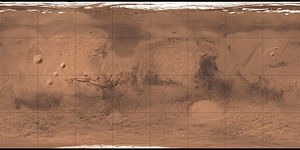Syrtis Major
| Plateau on Mars | ||
|---|---|---|
| Syrtis Major | ||

|
||
| Image of Mars with the Hubble Space Telescope. Syrtis Major protrudes from the south (below) into the lighter regions | ||
|
|
||
| position | 10 ° N , 70 ° E | |
| expansion | 1500 km | |
| history | ||
| discovery | Christiaan Huygens | |
| Date of discovery | 1659 | |
| Eponym | Latin for Great Syrte | |
Syrtis Major Planitia (the Great Syrte ) is an extensive plateau on the planet Mars .
history
Christiaan Huygens discovered Syrtis Major in 1659. On the basis of her position changes, he determined the rotation of Mars to be 24.5 hours (today's value: 24.623 h).
In November 2018, NASA announced the plane as the landing site for the Mars rover Perseverance, which was successfully launched on July 30, 2020 .
Areography
location
The nearly 2 million square kilometers, triangular-shaped plateau is located in the Syrtis Major Gradfeld , near the equator , at 19.41 ° north latitude and 76.64 ° east longitude of the center. In the north it borders on the Nilosyrtis Mensae , in the northeast on the Utopia plain, in the east on the Isidis plain, in the south on the Thyrrhena Terra and in the west on the Arabia Terra . The plain is around 1,300 kilometers wide and 1,500 kilometers long.
Surface structures
crater
In contrast to the flat, northern lowlands, the Syrtis Major has an increased crater density . In addition, they are mostly of a higher age and have therefore often already been partially or completely filled with volcanic material.
The plain contains the Jezero crater , which is also the planned landing site for the Perseverance rover .
Table mountains
The surface of the plain is characterized, among other things, by table mountains , which can be easily distinguished from the surroundings due to their lighter color. They were created when volcanic lava flows eroded the older highland material, leaving behind only the more stable, vertical rock formations.
Wind deformation
The landscape was strongly shaped by the prevailing winds from the east-southeast direction. At least in the recent past, the wind direction can be derived from the light wind drifts that have formed primarily on the side of the impact crater facing away from the wind.
The wind also causes the dark color of the plain. It is due to the fact that there are only small deposits of lighter Martian dust here, as this is obviously "swept away" by winds and settles in lower regions such as the eastern Isidis Planitia . Because of its color, Syrtis Major can be seen from Earth using smaller telescopes .
Origin of name
Syrtis Major is named after the Latin expression for ?? Great Syrte , the southernmost bay of the Mediterranean off the Libyan coast.
Individual evidence
- ↑ a b c d e A dark spot on Mars: The Syrtis Major region. German Aerospace Center, June 2, 2012, accessed on March 30, 2020 (German).
- ↑ a b Gray Hautaluoma: NASA Announces Landing Site for Mars 2020 Rover. November 19, 2018, accessed March 29, 2020 .
- ↑ Planetary Names: Planum, plana: Syrtis Major Planum on Mars. Retrieved March 29, 2020 .
